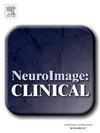Structural brain network organization in children with prenatal alcohol exposure
IF 3.4
2区 医学
Q2 NEUROIMAGING
引用次数: 0
Abstract
Introduction
There is growing evidence suggesting that children with prenatal alcohol exposure (PAE) struggle with cognitively demanding tasks, such as learning, attention, and language. Complex structural network analyses can provide insight into the neurobiological underpinnings of these functions, as they may be sensitive for characterizing the effects of PAE on the brain. However, investigations on how PAE affects brain networks are limited. We aim to compare diffusion magnetic resonance imaging (MRI) tractography-based structural networks between children with low-to-moderate PAE in trimester 1 only (T1) or throughout all trimesters (T1-T3) with those without alcohol exposure prenatally.
Methods
Our cohort included three groups of children aged 6 to 8 years: 1) no PAE (n = 24), 2) low-to-moderate PAE during T1 only (n = 30), 3) low-to-moderate PAE throughout T1-T3 (n = 36). Structural networks were constructed using the multi-shell multi-tissue constrained spherical deconvolution tractography technique. Quantitative group-wise analyses were conducted at three levels: (a) at the whole-brain network level, using both network-based statistical analyses and network centrality; and then using network centrality at (b) the modular level, and (c) per-region level, including the regions identified as brain hubs.
Results
Compared with the no PAE group, widespread brain network alterations were observed in the PAE T1-T3 group using network-based statistics, but no alterations were observed for the PAE T1 group. Network alterations were also detected at the module level in the PAE T1-T3 compared with the no PAE group, with lower eigenvector centrality in the module that closely represented the right cortico-basal ganglia-thalamo-cortical network. No significant group differences were found in network centrality at the per-region level, including the hub regions.
Conclusions
This study demonstrated that low-to-moderate PAE throughout pregnancy may alter brain structural connectivity, which may explain the neurodevelopmental deficits associated with PAE. It is possible that timing and duration of alcohol exposure are crucial, as PAE in T1 only did not appear to alter brain structural connectivity.
产前接触酒精的儿童大脑结构网络组织
导言:越来越多的证据表明,产前酒精暴露(PAE)的儿童在学习、注意力和语言等认知要求较高的任务中表现吃力。复杂的结构网络分析可以让人们深入了解这些功能的神经生物学基础,因为这些分析可能对描述 PAE 对大脑的影响非常敏感。然而,有关 PAE 如何影响大脑网络的研究还很有限。我们的目标是比较仅在第一孕期(T1)或在所有孕期(T1-T3)有中低度 PAE 的儿童与没有产前酒精暴露的儿童之间基于扩散磁共振成像(MRI)束成像的结构网络:1) 无 PAE(24 人);2) 仅在 T1 期间有低至中度 PAE(30 人);3) 在整个 T1-T3 期间有低至中度 PAE(36 人)。采用多壳多组织约束球形去卷积牵引成像技术构建结构网络。在三个层面上进行了分组定量分析:(a) 全脑网络层面,使用基于网络的统计分析和网络中心性;然后在(b) 模块层面和(c) 每个区域层面使用网络中心性,包括被确定为脑枢纽的区域。结果与无 PAE 组相比,使用基于网络的统计分析,在 PAE T1-T3 组观察到广泛的脑网络改变,但在 PAE T1 组未观察到任何改变。与无 PAE 组相比,PAE T1-T3 组在模块水平上也发现了网络改变,其中密切代表右侧皮质-基底节-丘脑-皮质网络的模块特征向量中心度较低。在每个区域(包括枢纽区域)的网络中心性方面,没有发现明显的组间差异。结论这项研究表明,整个孕期中低度至中度的 PAE 可能会改变大脑结构的连通性,这可能解释了与 PAE 相关的神经发育缺陷。酒精暴露的时间和持续时间可能至关重要,因为仅在 T1 期的 PAE 似乎不会改变大脑结构的连接性。
本文章由计算机程序翻译,如有差异,请以英文原文为准。
求助全文
约1分钟内获得全文
求助全文
来源期刊

Neuroimage-Clinical
NEUROIMAGING-
CiteScore
7.50
自引率
4.80%
发文量
368
审稿时长
52 days
期刊介绍:
NeuroImage: Clinical, a journal of diseases, disorders and syndromes involving the Nervous System, provides a vehicle for communicating important advances in the study of abnormal structure-function relationships of the human nervous system based on imaging.
The focus of NeuroImage: Clinical is on defining changes to the brain associated with primary neurologic and psychiatric diseases and disorders of the nervous system as well as behavioral syndromes and developmental conditions. The main criterion for judging papers is the extent of scientific advancement in the understanding of the pathophysiologic mechanisms of diseases and disorders, in identification of functional models that link clinical signs and symptoms with brain function and in the creation of image based tools applicable to a broad range of clinical needs including diagnosis, monitoring and tracking of illness, predicting therapeutic response and development of new treatments. Papers dealing with structure and function in animal models will also be considered if they reveal mechanisms that can be readily translated to human conditions.
 求助内容:
求助内容: 应助结果提醒方式:
应助结果提醒方式:


